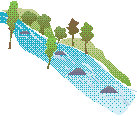|
Consider This FirstConsider how water distribution compares with the distribution of the human population. Locate the deserts and other low rainfall areas and compare those locations with a map of human populations. The pattern reflects how water has had a tremendous effect on human history. Early settlers always lived along the best water routes and even now population is clustered along the coasts. What does water offer a community? People may know why agriculture needs water, but why would industry need water? Water offers power (e.g., for textile mills), is part of many processes (e.g., paper manufacturing), cools (e.g., in nuclear power plants), and cleans. |
Now Think About the FactsMore than 200 rivers of the world are shared by more than two countries. Forty percent of the world’s population lives in watersheds that span more than one country. Twenty-six countries, many with rising populations, are water scarce already—that is, they have less than 1,000 m3 of water per capita. Nine of fourteen Middle Eastern countries are water-scarce. Access to water is an especially important issue for people living in the “water shadow” of a mountain range (a dry region created by the mountains’ topography), or living on overused lands, or living in parts of the world where air currents naturally pick up moisture. The potential for conflicts between countries over water is high. Human population growth ismaking it harder to access precious water. As water becomes more scarce, it will cost more. In countries where there are insufficient resources to pay for water, force may be considered a real option. It is especially important to have ways of resolving these types of conflicts peaceably and equitably. There is little agreement as to what determines who “owns” the fresh waterways. Countries have tried to capture water resources for their own benefit throughout human history, much as countries have tried to commandeer oil or precious metals. Negotiation is clearly preferable to force, however the rules for sharing water are unclear or not agreed upon. For example, one group might believe that a country should have full control over the water within its own borders, whereas others (particularly those downstream) argue that the whole watershed belongs to everyone and should be shared equitably. Rules for ownership have included positions such as these: • We got here first and built the dam (or reservoir), so the water belongs to us. (A related argument is that the other users of the water probably wouldn’t have been able to build the dam anyway.) • This water has always been sacred to our culture, so we should control it. • The water flows through our land so we can do with it whatever we want. • We share the river and although we live downstream, we have a right to the full natural flow of the river. • We have the right to do anything to our own waters as long as it does not injure the use of people downstream. • The whole basin belongs to all of us; all decisions have to be made by a council representing all the nations. Which of these do you think are reasonable positions? |
What Is the Law?
A Special Problem: The Middle EastOne quarter of Arabic-speaking people depend upon either aquifers or desalinization plants to obtain their drinking water. Many Middle Eastern countries depend on waters controlled by others. Egypt, for example, has almost no rain and imports most of its water. Saudi Arabia has no water but, because it has oil, it can pay for expensive desalinization plants. Jordan, on the other hand, does not have an easy way to buy water, and within 25 years its population will exceed its water supply. Unless a new source of freshwater is found, many more problems will arise including farmland salinization, public health risks, and industries not having access to water. Many Middle Eastern countries are projected to suffer radical per capita water losses over the next several years. For example, Egypt in 1990 had a per capita water ration of 1,100 m3 a year, which is predicted to drop to 600 m3 a year by 2025. Jordan, as well, had a per capita water ration of 280 m3 a year in 1990 which could drop to as low as 80 m3 a year by 2025. At least 12 Middle Eastern countries already import freshwater, over-pump groundwater, or use expensive desalination technique. References Naff, Thomas, “Water: ‘That Peculiar Substance’” (National Geographic Society, Research and Exploration, Vol. 9, November 1993, pp. 6-17). Postel, Sandra, Last Oasis (New York: W.W. Norton and Co., 1992, pp. 73-86). Return to Water Travels (World's Waters) Return to Upstream Downstream Index |
 Sharing Water: Background Reading
Sharing Water: Background Reading